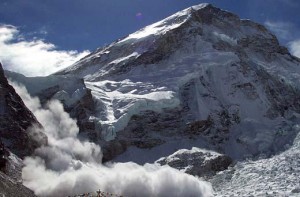Tourism business paralyzed after Fatal Avalanche at Everest Base Camp
Monday, April 28th, 2014 4:00:21 by Nadeem Bajwa
The gateway to Everest from the south side of Nepal is a mousetrap. The access to the broad valley at the foot of the Lhotse that leads to the hill south of the most coveted mountain in the world. Right there, at about 5,800 meters, 500 meters of altitude on the base camp, a landslide on April 18 resulted in the greatest tragedy of Everest mountain, that killed 16 Sherpas buried under tons of ice.
The Khumbu icefall is a maze of deep cracks and huge ice castles of great instability. A team of sherpas working there every day looking for the least dangerous route, placing metal ladders and fixed ropes to save their huge voids. Rupture of these masses of ice seracs is known as an unpredictable phenomenon, accelerated by the increase in daytime temperature. Typically, climbers pass around with the cold in the morning, fingers crossed. The Sherpas, however, spend the night and day before and after portaging their loads, so strange and forced to play Russian roulette. This past Friday, there was a new landslide in the same area, while the usual base camp climate change blamed the instability of an increasingly stark glacier.
The recent death of 16 sherpas activity has collapsed and paralyzed businesses. The tragedy has collapsed activity on Everest, paralyzed a tourism business that keeps you guessing to the Khumbu valley and forced the Government of Nepal to take action on the matter. Several companies have decided to cancel the guide season, respecting the pain of the Sherpa community. Others, however, want to go ahead and have the support of the government, whose representatives moved this week to the base camp of the mountain”urging”the parties involved to continue their work in the mountains. The economic factor has enormous weight and is at the center of a debate that divides even the Sherpas, those who have lost relatives in the landslide did not want to return to the mountains, punishes them some pain and superstition of his own culture and religion. But they are reluctant to give up a salary of between 4,000 and 6,000 euros for two months of work in a country where the average annual salary of just over 500 euros.
The voltage at the base camp remains high, although beginning to be late to equip the mountain and even without the help of all qualified Sherpas. After meeting at the base camp between government representatives, about 150 foreign climbers and 40 Sherpas, the vast majority of workers and decided to resign expedition to climb Everest.
In parallel, the Sherpa community has launched a cracking to the government demanding decent insurance in case of accident or death, as well as free helicopter evacuations. Pressure is the tonic in the Everest base camp. On the one hand, customers who pay between 40,000 and 100,000 dollars ( 28,000 and 72,000 euros) to seize a gap at the top to move their crave responsible companies guide (U.S., New Zealand, UK… ) and encourage these equip their sherpas as soon as possible mountain to get any good weather window is presented. In turn, the Sherpas are primarily interested in doing their job, matter of prestige and access to bonus they receive for placing customers at the top of the globe. But the real problem is not so much economic as security: can they really carry out their work without Sherpas become cannon fodder ?
Sherpa team that equips each year the Khumbu icefall and ensures maintenance is nicknamed Icefall doctors and is a working group to come up with the safest route around those most threatening seracs. They who certificasen hazard itinerary, highly complex and subject to many extreme conditions should be: one imagines an Everest closed to the public, however suicide resulting exposed to objective dangers unconscionable.
So far 264 deaths were recorded in the Everest, of which 103 were sherpas (43 died buried by avalanches ), but business must go on because there is big money at stake. The Khumbu icefall has always been a source of misery, a problem that threatens to grow to be unsustainable or cause a new butcher. The government of Nepal has hinted these days to prevent the closure of his favorite mountain could eventually allow supply field 1 helicopter in order to minimize human trafficking in the waterfall. It is hard to imagine a not so distant future in which the climbers and Sherpas arrive to camp 1 nonstop without touching the dreaded waterfall. Mountaineering and ethics do not talk, of course.
Short URL: https://www.newspakistan.pk/?p=43378

















